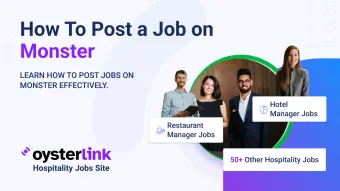The Most Common Form of Job Posting: Key Takeaways
- 55% of job seekers worldwide use the internet to search for jobs, highlighting the importance of digital platforms.
- Using targeted platforms based on industry, location and role increases the chances of attracting qualified candidates or finding the right opportunities.
- Tailoring job descriptions and resumes for each platform and maintaining a presence across multiple channels improves recruitment success and job search efficiency.
Nowadays, there are so many ways for employers and job seekers to connect — online boards, social media, referrals and more.
But what is the most common form of job posting? Whether you’re looking for a new role or hiring someone to fill an opening, knowing where to search or post makes all the difference.
Let’s explore the tools, platforms and methods that have shaped how both employers and job seekers connect today, helping you understand where to focus your energy for the best results.
A Quick Look at the Evolution of Job Postings
Not too long ago, finding a job often meant flipping through newspaper classifieds or hearing about openings through friends.
Job seekers relied heavily on word-of-mouth or searching through printed ads in newspapers, which could sometimes be time-consuming and limited in scope.
Traditional methods like networking and looking for signs posted in windows were also common ways of discovering opportunities.
Then came the internet, and everything changed. With the rise of websites and digital platforms, job hunting has become faster and more efficient.
The first major shift came with the introduction of online job boards, which allowed employers to post openings and job seekers to search through a wide range of listings.
This made job hunting accessible to a much larger audience, cutting down on the need for physical searches and opening up global opportunities.
The Most Common Form of Job Posting Today
So, let’s go back to our main focus: What is the most common form of job posting? That would be online job posting sites, which remain by far the most popular method for employers to share job openings.
Platforms like OysterLink, LinkedIn and Glassdoor account for the majority of job postings, thanks to their wide reach and ease of use. Employers can post a job in minutes, and job seekers can apply with just a few clicks.
According to a report by the Boston Consulting Group (BCG) and Recruit Works Institute, 55% of job seekers worldwide turn to the internet to search for jobs.
This shows that online job sites are still the most popular and effective platform for job postings.

Online job boards are so popular for a reason — they make life easier for everyone involved. Employers benefit from tools that let them filter applicants and track responses.
Job seekers love them because they can search by location, salary or industry, and even set up email alerts for new openings.
Plus, these platforms are optimized for mobile use, meaning you can scroll through listings or apply for jobs anytime, anywhere. Their ability to connect millions of people globally makes them a clear favorite in the job market.
See also: Recruitment and Hospitality Job Posting Compliance
How To Choose the Right Job Posting Platform
When it comes to posting job openings, the platform you choose can have a significant impact on your success.
Here are the factors to consider when selecting the best platform for your needs:
Target audience
Different job boards cater to specific industries and types of roles.
For example, if you're hiring for tech positions, platforms like Stack Overflow or GitHub Jobs might be a better choice than a more general site like Glassdoor.
Similarly, if you're hiring within the hospitality industry, OysterLink is the way to go. This platform is specifically tailored to connect employers with job seekers in the hospitality sector, offering targeted listings for roles like Valets, Event Planners and kitchen staff.
For job seekers, it’s also important to target platforms that align with their career goals.
For example, if you're looking to build a career in a specific field, using specialized job boards will increase your chances of finding positions that match your skills and experience.
Geographical considerations
Location plays a huge role in finding the right job or candidate.
If you’re the employer, selecting a platform with a strong presence in your area, or that caters to your region, is key.
For example, local job boards or specialized platforms might provide more targeted results compared to larger global sites.
Job seekers should keep geographical considerations in mind, too. If you're looking for work in a specific city or region, ensure the platform you're using allows you to filter for those locations.
Many job boards also offer location-specific filters, making it easy for both employers and job seekers to focus on nearby opportunities.
Platform features
For employers, choosing a job posting platform with the right features can save time and improve hiring efficiency.
Here are some features to consider:
- Filters: Many job boards offer filtering options to help you target specific candidate qualifications (e.g., years of experience, education, skills).
- Analytics: Platforms like LinkedIn or Glassdoor often provide insights into how many people have viewed your listing, where they are located and how many applications you’ve received. These then give you data that would help refine your posting strategy.
- Application tracking tools: Some platforms offer built-in applicant tracking systems (ATS) to help streamline the hiring process by allowing employers to organize resumes, communicate with candidates and track the status of applicants.
For job seekers, it's essential to look for platforms that provide comprehensive search filters such as job type (e.g., full-time or part-time), salary range or experience level.
Setting up alerts and utilizing the platform’s mobile app can also ensure you never miss an opportunity.

Other Forms of Job Posting To Consider
While online boards dominate, they’re not the only option. Here are a few other common ways employers and job seekers connect:
- Social media platforms: Instagram, Facebook, X and TikTok are increasingly used for job postings and networking. Many companies share openings on their social media pages, and job seekers can also use these platforms to directly engage with employers.
- Referrals and internal hiring: Word of mouth remains a powerful tool. Both employers and job seekers benefit from referrals, as employers often trust recommendations from current employees, and job seekers may land opportunities through their own network connections.
- Company career pages: Larger organizations and even smaller businesses sometimes post job openings directly on their websites. If you have a specific company in mind, checking their career page is a good way to stay updated on new roles.
- Traditional/in-person methods: Job fairs, industry events and physical bulletin boards are still relevant, especially in specific industries or communities. While less common than online options, these methods can provide valuable face-to-face connections.
How To Make the Most of Job Postings
Whether you're an employer or a job seeker, understanding how to effectively navigate job postings can save you time, increase your chances of success and reduce frustration.
By knowing how to approach the job search or hiring process, you can ensure better results. Here’s how both employers and job seekers can make the most of job postings.
For employers
Choosing the right platform is essential. Different industries often have specific job boards that attract the most qualified candidates, so it’s important to select the ones that best align with your hiring needs and target audience.
When writing job descriptions for postings, aim for clarity, conciseness and engagement.
A detailed job description will help set the right expectations and attract the right candidates. Make sure to include key responsibilities, necessary skills and insights into your company culture.
Additionally, leverage filters and keywords to ensure your listing stands out to the most qualified applicants.
For job seekers
Don’t limit yourself to just one platform. While major boards like Indeed and Glassdoor are excellent starting points, consider exploring specialized options.
For example, OysterLink is ideal for hospitality roles like Servers and Chefs. Meanwhile, Stack Overflow caters to tech professionals and Mediabistro specializes in media and creative jobs.
Many companies also post openings directly on their websites, and social media platforms can be a valuable resource for discovering hidden job opportunities.
Set up job alerts on multiple platforms to get notified about new listings as soon as they’re posted.
When applying, make the extra effort to tailor your resume and cover letter for each position, emphasizing relevant skills and experiences that make you a standout candidate.
The Power of Online Job Boards in Today’s Hiring Market
Online job boards are the go-to choice for job postings today, making them the most common and convenient way for employers and job seekers to connect.
Platforms like Indeed, LinkedIn and OysterLink have simplified the hiring process, offering unmatched accessibility and reach.
Whether you’re hiring or searching for your next opportunity, choosing the right platform can make all the difference.
Think about your target audience, industry and location, and don’t overlook specialized platforms that cater to specific needs.
By exploring multiple channels, you’ll give yourself the best chance to find the right fit quickly and efficiently.










Loading comments...